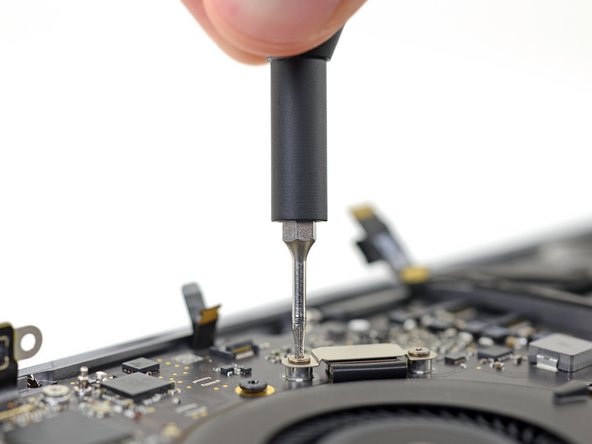Inleiding
Je bent waarschijnlijk wel bekend met de uitspraak "righty-tighty, lefty-loosey", maar we dachten dat het toch handig zou zijn om nog wat extra schroevendraaiertips op een rijtje te zetten. Zo kun jij je schroevendraaiertechniek perfectioneren en voorkomen dat je ooit nog een schroef doordraait.
Als je deze pagina te laat hebt gevonden, ga dan naar onze [gids|13213|handleiding voor het verwijderen van beschadigde en doorgedraaide schroeven].
-
-
Verschillende schroefkoppen vragen om verschillende typen schroevendraaiers. Of het nu gaat om Phillips, Japanese Industrial Standard (JIS), Pozidrive, Torx, Triwing of gewone platte kop, gebruik de juiste schroevendraaier of bit voor je apparaat.
-
Het gebruiken van een schroevendraaier of bitje dat bijna, maar net niet past—zoals bijvoorbeeld het losdraaien van een kruiskopschroef met behulp van een platkopschroevendraaier—kan soms praktisch zijn, maar levert vaker wel dan niet problemen op.
-
Maar moet je dan altijd niet een levensgrote verzameling aan schroevendraaiers bij je hebben? Niet per se! Je kunt namelijk een uitgebreide bitset scoren, zoals de 64 bitkit of de Universele bitkit voor grotere apparaten, zodat je weet dat je vrijwel alle schroefkoppen los kunt draaien!
-
-
-
Beginners maken vaak de fout om een te kleine bit te gebruiken. Een te kleine schroevendraaier(bit) glijdt gemakkelijk weg, waardoor de schroefkop wordt beschadigd. Hierna is het moeilijk om de schroef weer in of uit te draaien, zelfs met een schroevendraaier met het juiste formaat. Dit staat bekend als een gestripte of doorgedraaide schroef.
-
Een overmaatse bit past slechts ondiep of helemaal niet in de schroef.
-
Als je een bitje vindt dat ongeveer goed past, vergelijk dan de bits met een maat groter en een maat kleiner voordat je verder gaat.
-
Gebruik over het algemeen de grootste bitmaat die precies in de schroef past.
-
-
-
Houd je bits in goede staat door deze alleen te gebruiken waarvoor ze zijn gemaakt.
-
Wrikken met een schroevendraaier kan de punt buigen of breken, waardoor deze onbruikbaar wordt voor het in- of uitdraaien van schroeven.
-
Een schroevendraaier als beitel gebruiken kan de punt vervormen. De beschadigde schroevendraaier past dan niet meer goed in de schroefkop, met beschadigde schroeven tot gevolg.
-
Gebruik alleen bits die in goede staat verkeren om het beschadigen van schroeven te voorkomen.
-
-
-
-
Zorg dat je, bij het plaatsen van een schroef, eerst tegen de klok in draait om te zorgen dat de schroef op de juiste positie in het schroefgat geraakt alvorens deze vast te draaien.
-
Draai langzaam totdat je voelt dat de schroef waterpas staat en iets wegzakt, en stop dan.
-
Nu is het veilig om de schroef strak vast te draaien.
-
Als een schroef niet gemakkelijk vastdraait, draai je deze weer los, probeer je de schroef beter te plaatsen en probeer je deze nog eens strak te draaien.
-
-
-
Gebruik ten slotte de juiste hoeveelheid kracht bij het vastdraaien van de schroeven. Een goed vastgedraaide schroef zit goed vast, maar niet zo strak dat je schroevendraaier begint te slippen.
-
Zeer kleine schroeven, zoals die in telefoons en tablets worden gebruikt, vereisen zeer weinig aandraaikracht. Zodra je weerstand voelt, draai je nog maximaal een kwartslag (of minder) verder, stop daarna met draaien.
-
Annuleren: ik heb deze handleiding niet afgemaakt.
284 andere personen hebben deze handleiding voltooid.
Met dank aan deze vertalers:
100%
Deze vertalers helpen ons de wereld te repareren! Wil je bijdragen?
Begin met vertalen ›
4 opmerkingen
Regardless of whether you are a technician or a DIYer I strongly recommend that you buy the best quality screwdriver possible. Quality screwdrivers will last a lifetime or longer. Poor quality screwdrivers will quickly wear out making them useless and will damage the screws.
Quality brands - in no particular order and what I can recall at present - include PB Swiss, CK, Wera, and Snapon.
Excellent tutorial, Jeff! Thanks for creating this. I’m a 60 year old grandmother, and a widow…finding myself taking on repair projects these days that I never thought I’d ever be doing. But I enjoy tinkering and fixing things, or trying to make something “work better”. So it never hurts to review the basics….some of us missed some details the first time around. Thanks again :-)
I am a newbie to the ifixit community, recently changed the battery on my iPhone 6. I always appreciate the opportunity to review “basic” information on DYI skills and tools to see if I can learn new knowledge, as was the case with Jeff’s tutorial on the use of screwdrivers. :)
Great! Super happy to hear that!! If ever you’d need guidance around here, have questions or suggestions, don’t hesitate to reach out using community@ifixit.com. Right on!





















